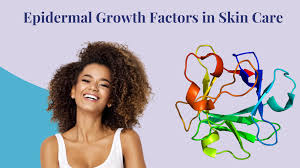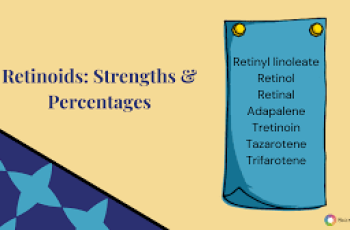Epidermal Growth Factor in Skin Care: Is It Safe? Why we are not sure.
Epidermal Growth Factor in Serums
Some growth factors (GFs) used as skincare ingredients are in the Epidermal Growth Factor (EGF) family. This family consists of four proteins, each characterized by a similar structure. Each of these GF proteins acts on identical receptors and exhibits the same biological activity.
Of these different GF proteins in the EGF family, this blog will discuss the Epidermal- Derived Growth Factor, the epidermal growth factor receptor, and the safety of epidermal growth factor in skin care.
What are epidermal growth factors?
What Does Epidermal Growth Factor Do?
Epidermal growth factors have several roles that make them attractive for use in skin care products. such as:
Stimulate the proliferation and migration of keratinocytes
Promote fibroblast motility
Regulate hair growth
Modulate the development of sebaceous and sweat glands
Increase hyaluronic acid (HA) production
Influence the wound healing process.
All of these are desirable attributes which explains the plethora of very expensive anti-aging serums with EGF.
What is the Epidermal Derived Growth Factor Receptor (EGFR)?
The Epidermal Growth Factor Receptor (EGFR) is a cell surface glycoprotein predominantly expressed in the epidermis’s basal layer and the hair follicle’s external root sheath. Its activation dynamics are influenced by extracellular matrix (ECM) elements, integrins, receptors for cytokines, and specific ligands binding to EGFR. Among these ligands are amphiregulin, betacellulin, epiregulin, EGF, TGF-α, heparin-affiliated EGF, and growth factors resembling EGF.(84)
Ultraviolet (UV) radiation is capable of activating EGFR.
What happens when EGFR in skin is activated?
Upon EGFR engagement with EGF or another ligand, a cascade involving tyrosine kinase and various signaling pathways initiates. These pathways oversee cellular activities like:
proliferation
differentiation
cellular senescence
apoptosis
Activated tyrosine kinase elevates cellular calcium concentrations and propels DNA synthesis. When EGFR is activated, it encourages the growth and movement of keratinocytes, enhances the activity of fibroblasts, and affects the skin barrier.
Notably, UV-induced EGFR activation leads to reduced apoptosis in keratinocytes resulting in an increased number of senescent cells. Senescent cells are known to contribute to skin aging. Many skin care products are geared to cause autophagy to reduce the number of these cells because increased senescent cells is linked to skin aging.
Best growth factors for skin serums
EGF Serums and Skin Care Products
EGF is a prevalent component in cosmeceutical preparations, along with other growth factors that enhance EGF production.
There are also skin care ingredients that inhibit EGF in skin.
EGF Inhibitors in Skin Care
This are likely much safer and can protect the skin.
EGFR inhibitors include:
genistein
quercetin
daidzein
glycitein
Research indicates that these EGFR blockers can curb the rapid growth of keratinocytes and alleviate skin scaling, especially when there’s an excessive EGF presence, such as seen with over-exfoliation of the skin.
Natural Growth Factors and Plant Derived EGF
There are natural forms of EGFR stimulators such as phytosphingosine-1-phosphate (PhS1P). This ingredient is derived from plant and fungus.
It’s imperative to note that EGF sourced from plants and fungi doesn’t offer increased safety over those originating from humans.
Dangers of epidermal growth factors
Safety of EGF in skin care products
The incorporation of EGF in cosmetics raises safety concerns since any substance triggering EGFR might potentiate the growth of harmful cells, potentially leading to conditions like skin cancer.
EGFR Inhibitors are used to treat cancers. This implies that stimulating EGF might not be a good idea.
EGFR inhibitors are used as cancer treatments to manage certain malignancies, including small cell lung cancer.
Systemic suppression of EGFR with these drugs can mitigate excessive growth of epidermal cells, it can also instigate side effects like inflammation, folliculitis, acneiform eruptions, xerosis, changes in hair growth dynamics, and nail disorders.
So we really do not know if EGF in skin care is safe- it is certain that it is affects many cellular processes.
Growth factors do not get into the skin very well when used topically. Maybe this is why we have not seen reported cases of skin cancer in those using EGF growth factor serums in their skin care routines.
DQH Knowledge drop: In your 20s, your skin cell turnover decreases. (Cell turnover is a key component in keeping your skin youthful.) You know what else slows down? Your collagen production. Starting in your 20s, collagen decreases by about 1 percent per year. Should you want to prevent fine lines and wrinkles, start by eliminating behaviors that contribute to premature aging. “If it’s bad for you, it’s bad for your skin,” says dermatologist Michel Somenek.
“Cigarette smoking reduces blood flow to the skin and causes premature wrinkling and a dull skin texture. Making the repeated pursed motion to inhale can also cause smoker’s lines. Alcohol and recreational drugs are toxins for the skin that damage its cellular structure and DNA,” Somenek tells us. “The faster you eliminate vices while you are young, the better chance your skin and body have to recuperate.” Also, adopting an anti-aging routine in your 20s is key. After all, the best offense is a good defense. We spoke to Somenek and experts Joshua Ross and Audrey Kunin to find out more.
Keep reading for the best anti-aging products for your 20s, according to skincare professionals.
Sunscreen
“We all know that the sun is the number one cause of skin aging and starting the prevention in your 20s is very important,” Ross says. “The majority of your sun damage won’t start to appear until you’re in your 30s, so don’t wait until you see it surface or you’ll be behind the curve. Stay ahead of it with a good-quality zinc-based sunscreen worn daily.”
Farmacy Green Defense Daily Mineral Sunscreen
An invisible sunscreen with SPF 30, plus botanical extracts meant to protect skin with tons of antioxidants. Bonus: It’s clean and fine to use under makeup.
Bareminerals Complexion Rescue™ Tinted Moisturizer Broad Spectrum SPF 30
Although we recommend you use your SPF and moisturizer separately, we also understand moments when you don’t have time or energy for that extra step. For those times, this bareMinerals moisturizer is a great thing to have on hand.
Vitamin C Serum
“A great introduction to anti-aging is to start with a vitamin C serum in your morning skincare routine,” Ross says. “It’s a powerful antioxidant that will neutralize free radicals and brighten the skin.” He adds that it’s a great way to counteract the effects of the sun’s harmful rays, which, as previously mentioned, are among the biggest causes of premature aging.
Drunk Elephant C-Firma™ Vitamin C Day Serum
The Drunk Elephant C-Firma is a lightweight serum that promises to give skin a glow by combining the brightening powers of vitamin C with ferulic acid, l-ascorbic acid, and vitamin E. The included sodium hyaluronate is meant to replace hydration loss, so you shouldn’t have to deal with any irritation.
Sunday Riley C.E.O. Rapid Flash Brightening Serum
This potent serum is jam-packed with vitamin C (15 percent, to be exact), which means it’s a potential superstar at both brightening skin and dousing it in antioxidants.
Peptides
Using peptides on your skin has many benefits, says Somenek. “The skin barrier is what defends the body against pollution, UV rays, bacteria, and toxins. It can be damaged by several everyday factors. Using topical peptides aids in building a stronger barrier,” he says. “Peptides comprise elastic fibers, which are a type of protein. These fibers help to make skin appear taut and firm. Peptides can also help repair damaged skin, relieve inflammation, and even out skin tone. Some peptides can kill acne-causing bacteria that is common in 20-somethings.”
Kunin agrees, saying, “Peptides are an excellent entry point for supporting collagen.” She recommends looking for face and eye treatments that contain these collagen-boosting powerhouses.
Charlotte Tilbury Magic Eye Rescue Cream
This Charlotte Tilbury super-emollient eye cream has a base of coconut oil and shea butter (read: it’s incredibly hydrating). Botanicals plus peptides are meant to help reduce dark circles and boost collagen, respectively.
This creamy moisturizer serves up potent collagen-boosting peptides and pycnogenol, and antioxidant-rich vitamin C. “Instead of sitting on top of the skin, peptides penetrate the outer layer so they go deep. The ‘signals’ they send tell the cells to produce elastin and collagen, which are needed for youthful-looking skin,” explains Somenek.
At-Home Peel Pads
Remember that skin cell turnover fiasco we talked about earlier? One way to help support it is by exfoliating. “Exfoliation is important to help keep skin fresh and luminous,” Kunin says. She recommends using at-home peel pads as an easy and effective way to exfoliate.
“The goal in your 20s is to fight the slowing pace of cell turnover. It is wise to use products that gently exfoliate, yet still remove oil and other impurities. Products that have Alpha Hydroxy Acids (AHA) or Beta Hydroxy Acids (BHA) are a good choice.”
According to Somenek, you should only exfoliate two to three times a week. “People of all ages are guilty of over-exfoliating and that can be too much of a good thing,” he says.
Dermadoctor Kakadu C Intensive Vitamin C Peel Pad
A few swipes of this Derma Doctor powerful peel pad promise to leave your skin glowing and smooth, thanks to the seven (yes, seven) types of chemical exfoliants, including AHA and BHA. It also contains vitamin C via Kakadu plum extract for added brightening and antioxidant protection.
KEY INGREDIENTS Kakadu plum extract is sourced from the Kakadu plum, a fruit grown in northern Australia. It contains vitamin C, which restores the skin’s natural barrier, increases collagen production, and soothes irritation.
Dr. Dennis Gross Skincare Alpha Beta® Universal Daily Peel Pads
These are the gold standard of peel pads, with a cult following and over 900 five-star reviews on Sephora. They’re easy to use and contain a blend of anti-aging exfoliating acids.
Emollient Night Cream
“In your 20s, you need to start upping the hydration in your skincare routine. You may have been cautious of over-moisturizing because of acne in your teens, but as you enter your 20s, your skin transitions and becomes drier,” Ross says. “I recommend an emollient night cream added into your evening skincare regimen.”
“Twenty-somethings need to make sure that they are not using creams that will clog their pores and cause excess oil production,” says Somenek. Opt for non-comedogenic products.
Cerave Skin Renewing Night Cream
One great choice is the CeraVe Skin Renewing Night Cream, which is a non-comedogenic night cream that leaves skin soft and glowy. It combines the moisturizing powers of ceramides and hyaluronic acid.
RoC Retinol Correxion Max Hydration Creme
“The best night cream ingredients contain retinol, benzoyl peroxide, and/or salicylic acid or hyaluronic acid. The goal is to moisturize, yet remove excess oil,” says Somenek. This Roc Retinol Correxion cream fits the bill as it contains both hyaluronic acid and retinol so it promises to moisturize while also being non-comedogenic.



